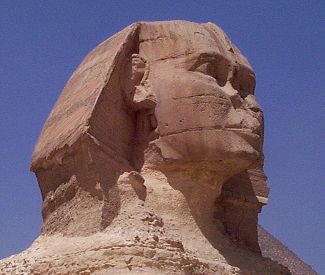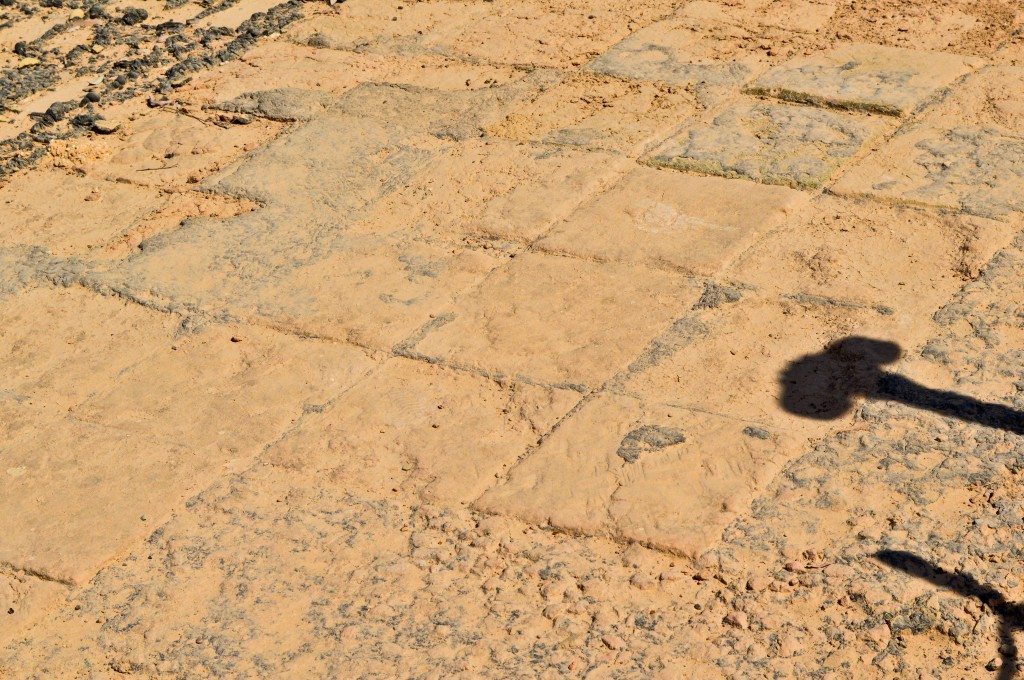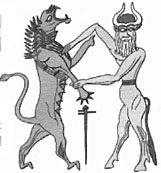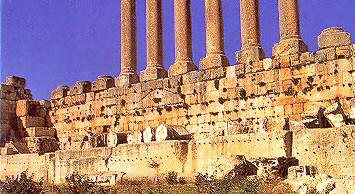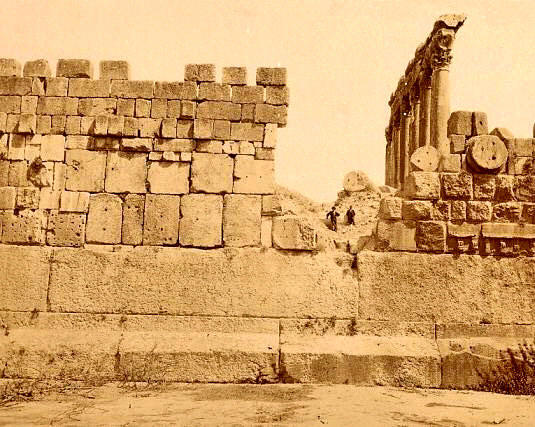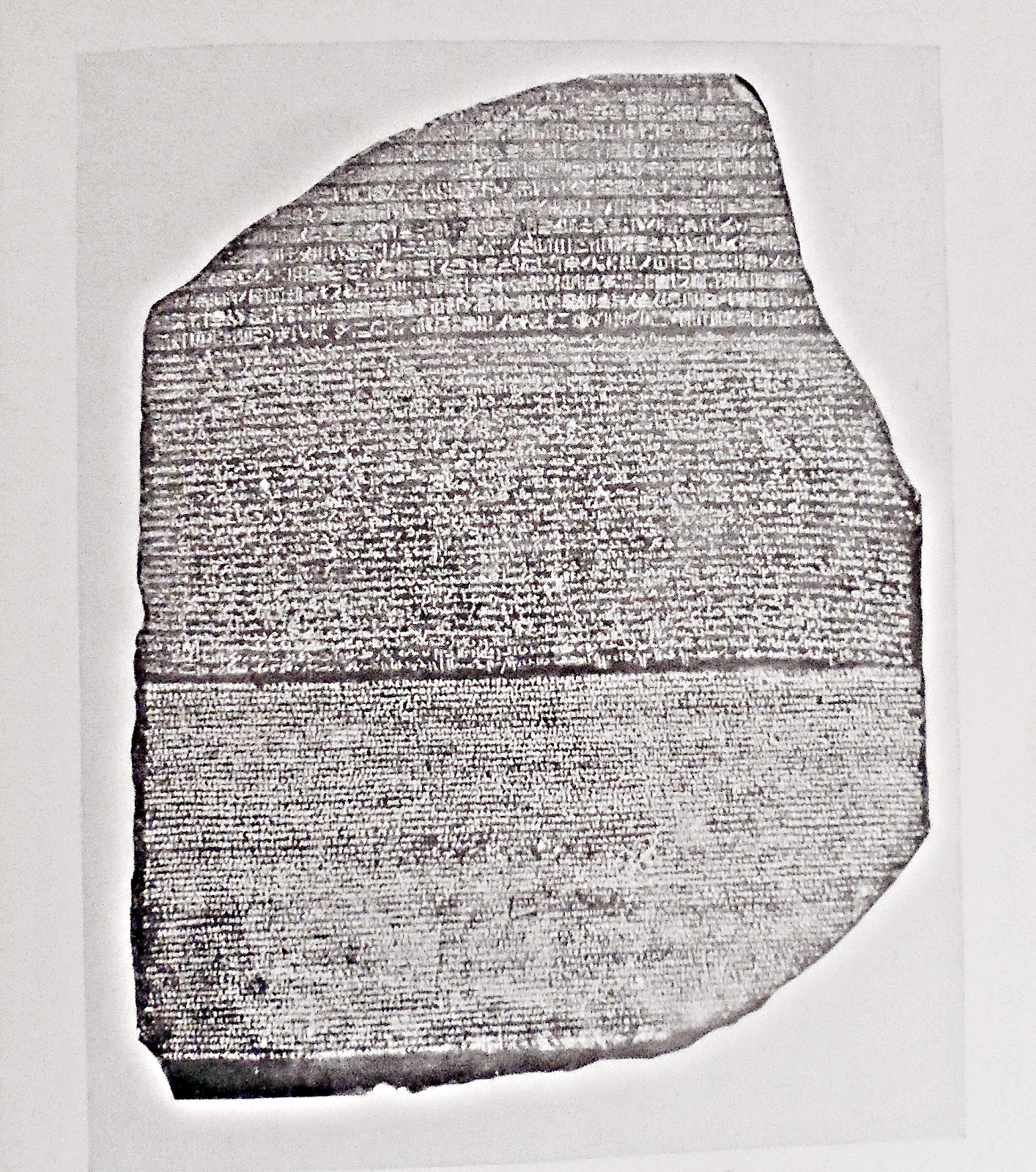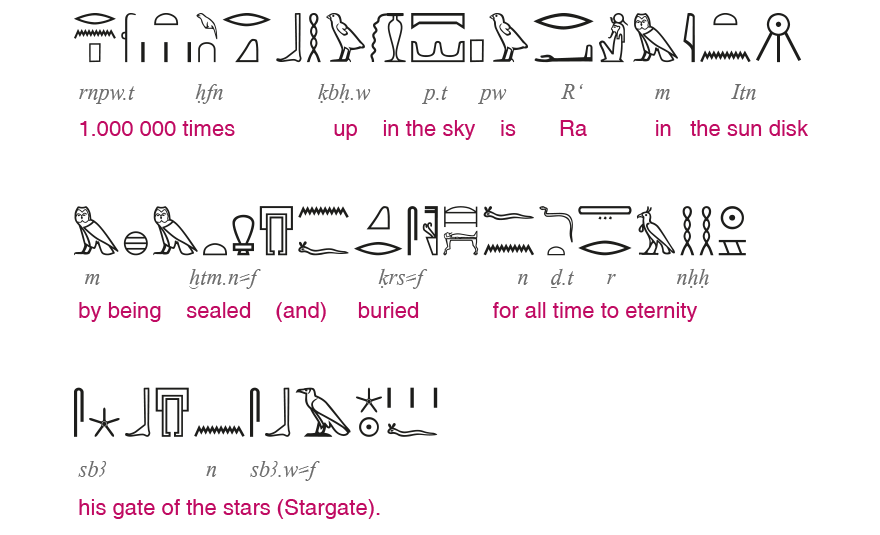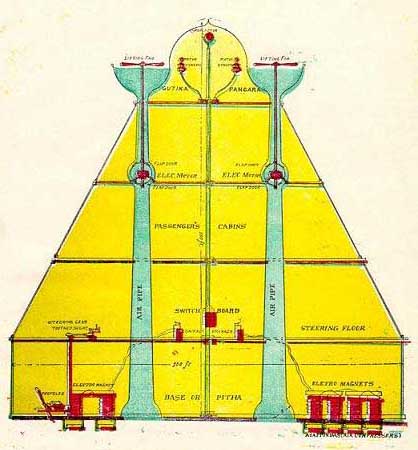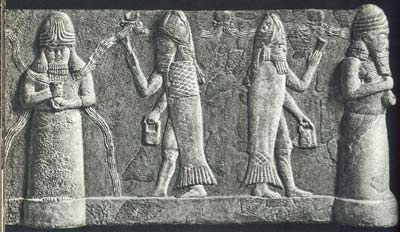The Sumerians
Human history from a recorded historical view begins in the lower Mesopotamia, which means between the rivers. These two rivers are the Tigris in the north and the Euphrates in the south, which both drain into the Persian gulf. All of the major cities in ancient times with one exception, were built on the Euphrates, and none on the Tigris and for several good reasons.
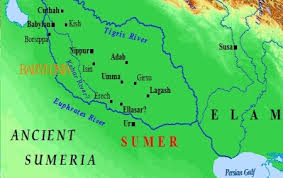
The map of the Euphrates shows the ancient cities, that are no longer on the river, as the river has changed its course over time.
The most important fact was that the Euphrates river facilitated itself to irrigation more so than the Tigris. The banks on the Euphrates are low and flat, while the banks of the Tigris are high, and more rugged, which would've meant the water from the Tigris, would have to be lifted, in order to irrigate. This also meant that the Tigris river banks were stronger not allowing the river to shift it's course through time. This was the exact opposite to the Euphrates, which through time has seen many major changes in it's course flowing south. Many burial mounds of cities that existed in ancient times on the Euphrates are now miles east or west of the current Euphrates. These include the cities, Babylon, Kish, Nippur, Uruk, which all at one time in their early existence, were situated on the Euphrates. Through diggings and the findings of ancient texts, it can now be determined without question, that these cities were all built on the Euphrates. This can be proved by one of Hammurabi's texts, that describes an order to dredge the Euphrates from Larsa to Ur, “clean out the stream of the Euphrates”. Both of these cities today, do not exist on the southern Euphrates.
In comparing the ancient course of the Euphrates to the one that exists today, two very noticeable differences can be made. The middle course of the Euphrates has shifted dramatically west, while the very southerly section has shifted to the east.
The most notable geographical feature relating to the Mesopotamian valley is the flatness of the land, particularly near the Euphrates. This lends itself to intensive farming. The flatness of the valley has one very notable downside in ancient times. This was the fact that it's large and powerful cities, were difficult to defend. There was no natural defensive obstacles that would hinder the movement of invading armies. Wars and their subsequent armies were a very common occurrence in ancient times, and they all passed through the Mesopotamian valley. The other common feature that exists throughout this valley delta, is the lack of building material. With the exception of clay to build bricks, there is no stone, so the mighty cities along the Euphrates were all built of clay bricks, which over time, turns to mounds of dirt. There is one exception and that is the city of Eridu,( considered man's first city), which had some stone in it's construction.
The ancient city of Eridu, one of the five preflood cities, exists today as a mere dirt mound in modern southern Iraq. Clay bricks eventually turn to dirt, and without water for irrigation, these cities were eventually abandoned.
These mighty cities of the Euphrates were in sharp contrast to the stone monuments erected by the Egyptians, which still stand today. The other downside to clay being the only building material, is that clay is the only material to write on. Hence clay tablets are all that exists today from this period, to study and learn from their culture. Though many have survived, clay tablets as a writing surface are not the most enduring. This again can be in contrast to the Egyptians who painted or carved their language onto stone. The Egyptian also wrote on papyrus, but many only exist in fragmented form today.
The first people to live in this valley were the Sumerians. They lived in the very southernmost region, bordering the Persian gulf and they called their valley, Sumer. The Sumerians were the first in human history to have a written language. Symbols or letters that represent a phonic sound is what defines a written language, which is quite different than a series of pictures to represent an event or action. They wrote their language on a wet clay,often using a stylus. This form of writing came to be called cuneiform writing. They also developed a basic law code, and a legal system using cuneiform to keep legal records.
The Sumerians had Gods. The highest of these Gods was Anu, meaning heavenly one, or God of Heaven. The Princely offspring of Anu, were called the Anunnaki, meaning born of royal blood, and these lived amongst the Sumerians in a very symbiotic relationship. Within the Anunnaki there was a counsel of leaders that directed and led the Anunnaki. These Gods had no spirit form, as the God of the Bible. They were not perfect, all knowing or omnipotent. They were of human form, had human interest, as in they liked to drink beer, and have prolific sex with the beautiful women of Sumeria. The reason they were seen as Gods to the Sumerians is that they possessed technologies, unknown to the Sumerians. These technologies and sciences were taught to the Sumerians to improve their methods of intensive farming. Simple math, and building techniques were also taught. Therefore the Sumerians called them Great Gods. In essence the Anunnaki provided the technologies and the Sumerians did the work.
The Sumerians were modest and humble which is reflected in their dress, consisting mainly of a simple tunic. They were clean shaven, and also were thought to shave their heads bare. In a more formal setting, the Sumerians would wear wigs. This form of modest dress was possibly in showing respect, as in having a humble attitude towards their Great Gods, whose dress was in sharp contrast to the Sumerians. These Anunnaki wore heavily embroidered garments similar to Roman togas, with end of the material flung over one shoulder. Their beards were long and braided, and their heads were full of wavy hair. The Annuna also wore a headdress which was the inverted horns(horn tips pointed inward)of a bull. This was evidently signaling their higher position in their order. The Sumerian men below show their simple dress appearance.
The Sumerians were soon to have neighbours to the north of their valley. They were to be called Akkadians, named after their capital Akkad or Agade meaning born of Akkad. In Genesis 10:10 it mentions Akkad, pronouncing it Accad or in Greek Archad. The Akkadians were thought to have come from the south, led by their Anunnaki God, Dagan.
These Akkadians were the first Semites on earth, and not of the same race as the Sumerians. The roots of the word Semite, is semen, and seed, these people being the seed of Dagan, their God. Their language was distinctly different than the Sumerians. The Sumerian language was built, by starting with a word and building more words around that single word to develop more complex thoughts and phrases, while the Akkadian language used roots, which may or may not have any meaning, then by changing letters with the root, different meaning are derived. The Akkadian language can be likened to an early version of Hebrew and as in our English language used roots, while the Sumerian language had no language that would, living or dead, be considered close to their ancient spoken or written language. The Akkadians did not have a written language so they borrowed the cuneiform style of writing from the Sumerians.
Both Akkadians and Sumerians were competing for the same resources, food and land, on a very limited valley, which would have brought them into conflict. This conflict met its zenith, and turning point with the birth of an Akkadian King, named Sargon. Dagan as all Anunnaki (Great Gods), had courtships and sex with numerous desirable and beautiful females within the region, and once Dagan saw a Priestess of Kish, that was especially beautiful, he sought her, and from this relations she gave birth to an illegitimate child, who came to be called Sargon. Through a series of events her son, Sargon becomes king, and immediately, sets out to conquer the entire southern Mesopotamia , including the Sumerians. With the help of Dagan, Sargon butchers and annihilates all the neighbouring territories and city states. Before long Sargon has the great southern Sumerian city of Ur in a long protracted siege. After it's fall and with the Sumerian victory complete, he washes his hands and sword in the Persian gulf, as if saying he's “finished with it”, similar to Pontius Pilate washing his hands, centuries later. This then establishes the Semite kingdom as a leading power on earth, and abruptly ends the people of Sumer. Sargon's military victories enables Dagan's Semitic Kingdom to become the first, dominant power in earth's history.
Early Sumerians all had one thing in common through out their many reliefs that illustrated them as a people. They were illustrated most often as naked. These illustrations depicted the early Sumerians as totally naked as they went about their daily chores. Totally without shame, similar to the Bible's story of Adam and Eve. They appeared on these reliefs also without any facial or body hair. Even their heads were hairless.
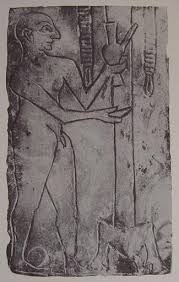
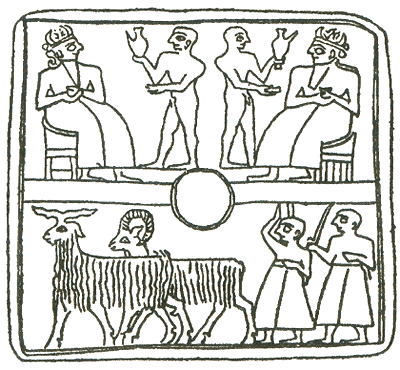
The Sumerians above are at work serving drink and food totally naked and hairless. These early Sumerians were called, "the black headed people", which seems to indicate, by the phrase "black headed" that they had no hair on their heads, or exactly as they were illustrated in their reliefs.
The Sumerians were in direct contrast to their Great Gods. These Gods, seen in the figure below, had enormous amounts of body and facial hair. If you look closely to their facial features, in the relief below, you'll notice large over sized eyes, large drooping noses, and over sized ears. These features are often seen amongst the people of India and the Indus Valley. Did these Gods and their prolific sexual encounters with the women of the valleys of Indus and Sumer transfer their genes to man, that produced body hair and distinct facial features?
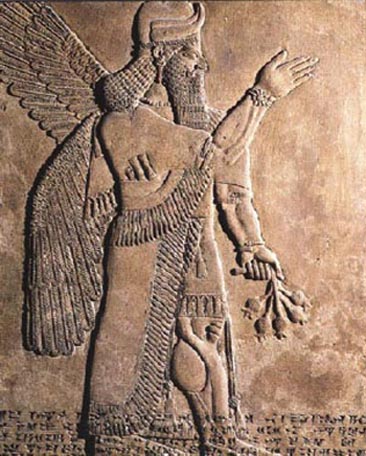
Native peoples today, throughout the world, are basically without body and facial hair. Native people of North and South America, along with native peoples in the Pacific Islands, do not have facial beards. The reason for this, would be that they had no direct contact with these ancient gods. Peoples that have facial hair today are from the Middle East and the India. As civilisations moved North and West, these genes came with them. Central and Western Europeans also have this gene for facial hair. Still man's early gene that produced no head of hair, often appears as baldness, as seen in many Western European peoples.
This seems to confirm that mankind today, is a hybrid of early man and their gods. The genes of both are apart of modern mankind.
The Sumerians also had their Hero's. Gilgamesh was the greatest. He reigned as the King of Uruk, so he was both a mythological figure and a real figure. The acts he performed distinguished his bravery, which resulted in these stories gaining mythical proportions. These elevated tales of Gilgamesh were discovered in the British Museum in 1872, by George Smith. These tablets were earlier brought to England from their discovery in the great Library of Nineveh.

Shown above is a relief of Gilgamesh, with his full facial beard, which he would have inherited from his mother a goddess. He therefore was what the Greeks referred to as a demi god, because he was half god. The genes of his mother were now part of his DNA.
The tales of Gilgamesh and his heroic adventures, can be likened to a Greek Heroes. The Greek tale of Jason and the Argonauts describes his adventure into the Black Sea in search of the golden fleece. The account is so well described that it allows modern readers of the tale to follow his exact travels. This is similar to the tale of Gilgamesh. His great adventure likewise can be followed, as if on a tourist map, as he slays evil and monsters alike.
The Tale of Gilgamesh also has an entirely different twist. In the
Book of Enoch; which has several books including The Book of the Giants, Gilgamesh is mentioned twice. The only time his name is mentioned outside of cuneiform text. His name mentioned twice from two completely unrelated sources points to him being an actual personage. The text from the Book of Giants; the giants are discussing a dream;
1 concerns the death of our souls [ . . . ] and all his comrades, [and Oh]ya told them what Gilgamesh said to him 2[ . . . ] and it was said [ . . . ] "concerning [ . . . ] the leader has cursed the potentates" 3 and the giants were glad at his words. Then he turned and left [ . . . ]
Gilgamesh is a hero figure, as in Sumerian text, but in the Book of Giants, the opposite is true. He is part of the Nefilim (giants) and monsters, that inhabit the earth and bring ruin and evil upon it's people. Quite a shocking difference. In the Book of Giants it states that 200 Gods (watchers) came down to earth and had relations with earthly women and animals that produced offspring, that were called giants and monsters. Book of Giants reads;
they defiled [ . . . ] 2[ . . . they begot] giants and monsters [ . . . ] 3[ . . . ] they begot, and, behold, all [the earth was corrupted . . . ] 4[ . . . ] with its blood and by the hand of [ . . . ] 5[giant's] which did not suffice for them and [ . . . ] 6[ . . . ] and they were seeking to devour many [ . . . ] 7[ . . . ] 8[ . . . ] the monsters attacked it.
In the Sumerian account it speaks of 300 gods, (annunaki) that come down to earth, and administer the fate of man. A certain Sumerian does run with wild animals and has sexual relations with them, but this is frowned upon by Gilgamesh and the other Sumerians. Gilgamesh then takes necessary steps to stop these illicit acts. This is one of the discerning points of Enoch's account and the Sumerian account, and the Bible's account is the resulting offspring between man and gods were described as Giants. While the offspring from the gods and animals are described as monsters. Stated " they begot giants and monsters"
Gilgamesh, though seen as a Sumerian hero, but still is definitely a Nefilim, controlling the fate of man, taking what he wants, including wives for himself. Sumerian test reads;
"Gilgamesh did not allow any virgin to be together with the one she loved,"
In the Bibles account this offspring, between man and gods, is sinful, and leads to ruin, that must be destroyed and removed from the surface of the earth. In the Sumerian account the Nefilim were to lead to man's genetic improvement, and ultimately improving his physical statute leading to their position as leaders and kings. The question that the Book of Enoch raises is would this level of mankind cooperating with the Nefilim continue forever? As the Book of Enoch suggests there is an eventual conflict, between man and the Nefilim.
In the dreams that the giants are having, it would point to their destruction. They become frightened and ask Enoch to interpret their dreams. Enoch tells of their fate, which is the result of the ruin that they have brought upon the earth.
These two varied accounts really illustrate the Bible's religious view of good v.s. bad, sex and it leads to sin theory, which is in direct contrast to the Sumerian account which would embrace the idea of miscegenation for enhancing mankind. Conflict though, would soon arise.
The Sumerians had a counting system based on 60, (10 and 6). This seems rather difficult in calculations, but this system, has given us the 60, in seconds in a minute, and 60 minutes in an hour. The Sumerians also had a rather developed legal system, and the one significant thing we still use from them today is the seal. Any legal document had to have seal before it was considered legal. This carried on down through Roman times and even today. That little red dot beside your signature on a legal document, is from the Sumerian seal.
The Sumerians left us with our first written language, our first legal code, and an insight into mankind's earliest developments of civilization.
For further reading;
http://trueancienthistory.blogspot.ca/2013/06/the-temple-ruins-at-baalbek-lebanon.html


